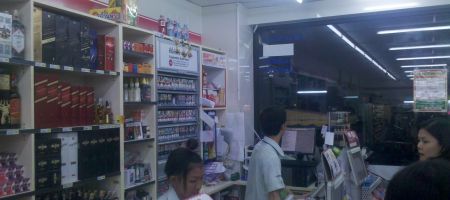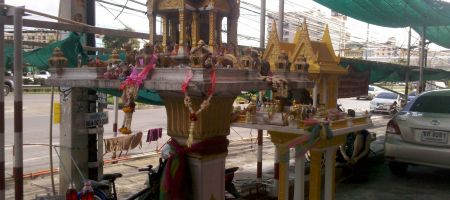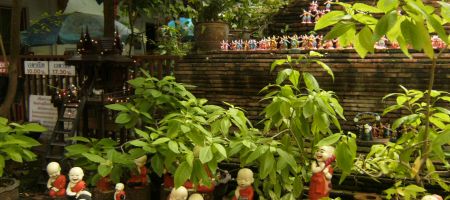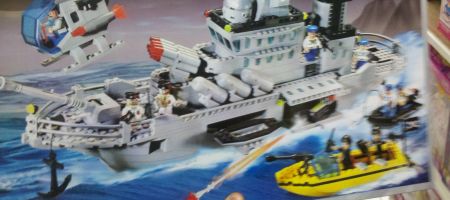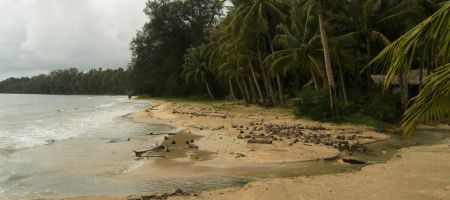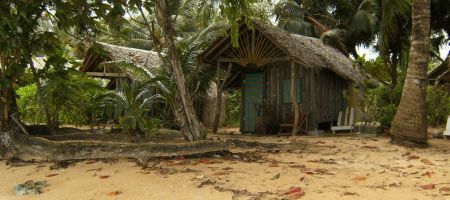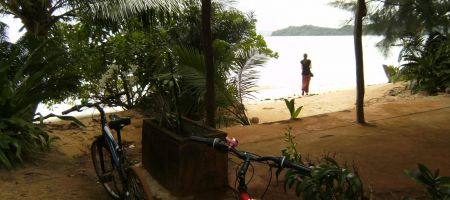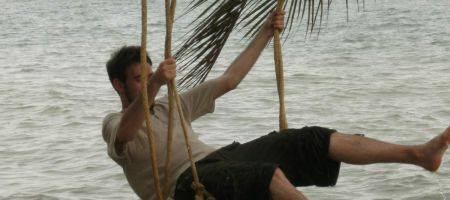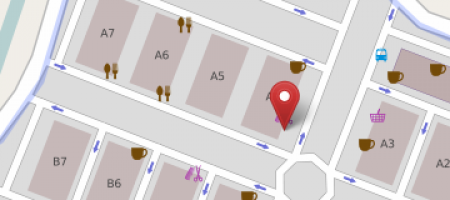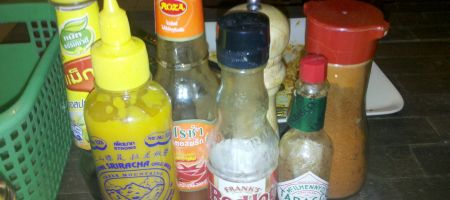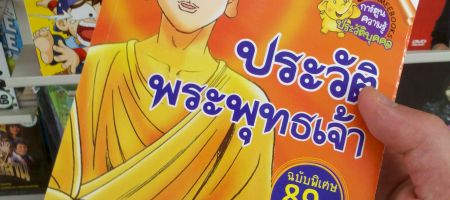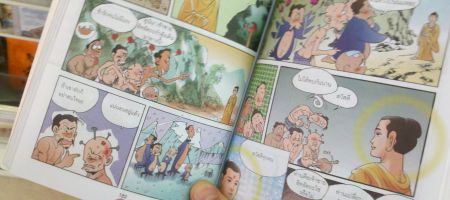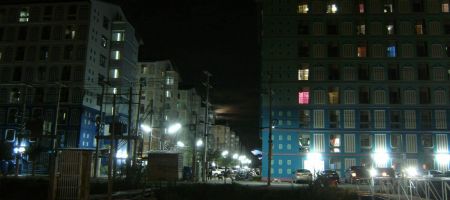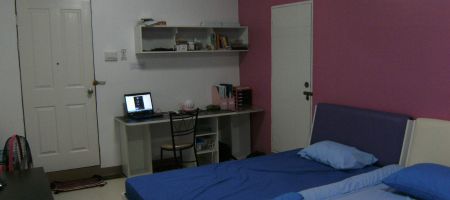Big Business
Part I: My spirits fancy straws
Part II: Big Business
Part III: Thai Religion
The belief in spirits is not the only thing carried over from archaic religions. Particularly often near or sometimes even inside Buddhist monasteries, there are amulet markets where various talismans and other lucky charms are being sold. Many of these talismans are Buddha figurines, but also tiny framed pictures of famous monks are popular.
If a talisman is blessed by a monk, it increases its value somewhat depending on the status of the monk who blessed it. All with proper certificates of course.
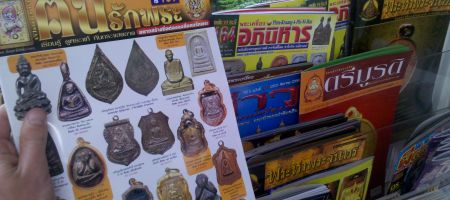
I took this picture in a 7-Eleven supermarket, those supermarkets are around every corner. The trade with talismans is so big, there are even magazines about it. There is a whole science connected with talismans which is not just about the value and the effect it is said to have but also there are delicate rules how you treat the talismans, otherwise they could loose their power.
But monks do not only earn money by blessing amulets, whole cars can be blessed as well to protect them from accidents. 1
On the topic of Thai spirit houses, the Wikipedia (currently) has to say that this is an animist belief that is tolerated nowadays by Buddhism in Thailand. But what I saw so far, it is not tolerated at all. No, it is part of the religion and in Thailand even though it is not a Buddhist thing, the Buddhist monks actively participate in it.
Good money, as well. And on the topic of amulets, I claim that they almost run the thing.
And all this business is kinda problematic because actually, monks may not have or use any money.2 Something the Thais are very particular about. Recently there had been scandals of high-ranked monks being accused to disrespect that law, one was accused to own an airplane and several houses in the USA.
Instead of giving money, there is the practice of giving food and everyday items to the monks. Buddhist monks do not beg, people give them food and all the other things they need in order to improve their own karma. This is common in Buddhism. As Thailand is a modern capitalist country, this kinda got streamlined into the product of those “orange buckets”, in cities at least.
These orange buckets are conveniently pre-packaged offerings that contain everyday products for monks. Depending on the “brand”, sometimes included are also things like flashlights and other non-disposable stuff where I start asking myself how many flashlights they might (have to) “consume” per day. They can be bought in many convenience stores, supermarkets and, interestingly, sometimes right in front of the temple on monastery premises.
Rumor has it, that they don’t open many of the buckets anymore but sell them back to the shops to buy something more useful (like rice, maintenance costs for the buildings etc.). It is only a rumor because Buddhist monasteries plus money is kind of a taboo even though everyone (should) know it is hard to do without.
1 A practice though that can’t be said to be unique in Thai culture (scroll down).
2 Buddhist monks should not use any money because enjoying luxury or involving yourself in any kind of trade distracts you from the path to enlightenment. Christian monks should not have any money because it makes you corrupt.

My spirits fancy straws
Part I: My spirits fancy straws
Part II: Big Business
Part III: Thai Religion
Religion is amongst my favourite topics to write about. But it is also one of the most difficult ones. It’s hard to wrap yourself around it and I don’t want to jump to conclusions too quickly.
In India, when I asked people about some aspects of their religion, they gave me at least a half-decent explanation or told me a story about it. In Thailand, the religion is in my opinion much less … approachable because it is less apparent, there is the language barrier and it is interwoven with this whole submissiveness and hierarchy shit they practice here.
Recently I walked into a 7-Eleven mini-supermarket and saw some small shrine on top of a cupboard behind the cashier’s counter. It consisted of a few open red Fanta bottles with straws inside and some religious decoration around it.
I asked what this is for but the only answer I got from them after minutes of discussion in Thai amongst each other was “Religion of Thai people”. In general they seem to be embarrassed even to be asked about such things. And to embarrass someone or to make him feel insecure is considered rude – as Lena never misses to point out to me.
By the way, I already figured out what the shrine was for from what Lena told me about it but I would have liked to hear it from them first-hand:
Those are offerings to the spirits of the house. A tribute to the spirits to leave the humans alone. Spirits like blood, that is why they fancy the red Fanta (strawberry flavour in case you wonder) because apparently they mistake it for blood.
Spirits live in every house occupied by humans, they are not the ghosts from the deceased but ferocious beings which must be appeased or fooled. (And fooling them seems to be quite easy.)
Spirit houses are a common sight in Thailand. These miniature houses are often found in front of family houses and yes, also sometimes in front of Buddhist temples.
I did not find out the reason for the little statuettes in and around the spirit houses yet, do they resemble or somehow imprison the spirits? Or do they “serve” the spirits like the Egyptian Ushabti served in the afterlife? Or something else entirely? What’s the deal with those statuettes of those happy-baby-monks? Are these perhaps just the Thai counterpart to the German garden gnomes?
And the reason for the straws? Well, that one is easy actually. Thais simply put straws in everything!
Bought a can of Coke? Here is your straw with it.
Buying a litre of milk? Don’t forget your straw!
You ordered a beer, Mister? There you are, and here is your straw!1
No reason to make an exception for the bottle of blood offered to the spirits, is there? Who knows, perhaps the spirit will even get suspicious about the nature of that “blood” if there is no straw in the bottle.
In reality, ants do really fancy the red Fanta and use the straws to climb down the bottle, rats and other vermin take care of the rest at night until it is replaced with new offerings.
But these animist practices are all quite unusual if you note that the state religion of Thailand is Buddhism, isn’t it? “Buddhism” in Thailand is not at all like what I learned it to be in India and Nepal. But well, more on that next time…2
1 Bought half a dozen of yoghurt cups for home? Here are your half a dozen disposable plastic spoons with it!
2 See the orange bucket on top of the cupboard on the first photo? This will be a topic in the next article about religion.

LEtsGO
Checking out the LEGO ripoffs…
I saw LEGO only once alongside a bigger selection of LEGO ripoffs in one department store. Otherwise, Enlighten, COGO, Megabloks and the crowd dominate the market here.
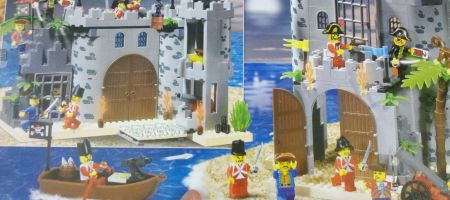
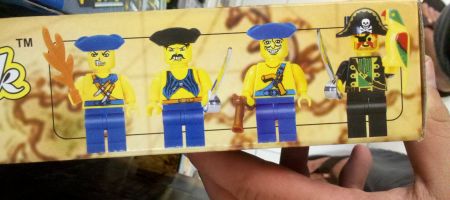
The Enlighten sets look really good though, some sets are clear copies of old LEGO sets, others are only inspired by original sets but quite nice on their own. But, take a look at the faces!
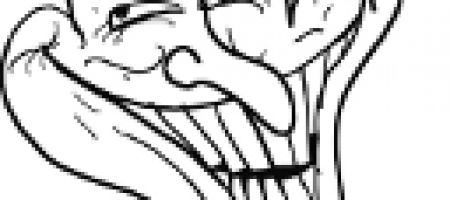
Bought a small set to test the quality. I have to say, it’s quite good. Also, Enlighten boasts this military themed series named “Combat Zone”:
Then there is Megabloks. They have this World of WarCraft series, quite impressive, check this out:

COGO on the other hand already looks shitty on the box art and as far as the quality is concerned, the new pieces don’t even fit together properly. At least the pieces from the one completely built set they displayed in the store.
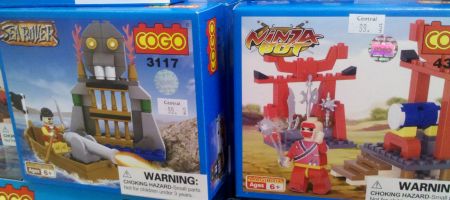

Gasolina
Here are some pictures of some less common gasoline stations. But still they can be seen here and there. Thailand shows that the gasoline business might not have to be a monopoly.
Imagine, what if it were common in Germany that bakeries also sell gasoline? Would it be weird? No, if it was common, it would be common, it’s just a matter of what we learnt to consider normal.
In other countries, there are no bakeries at all and people buy plastic-packaged single slices of toast readily smeared with sweetened “butter” like bags of crisps in the next 7-Eleven (yes okay, talking about Thailand here ;-).
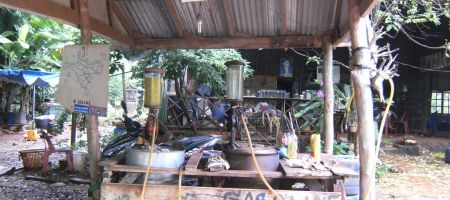
On Ko Mak. I absolutely love this photo, note all the little details: You can get GASOLINE (alternatively G ZOLINE) or DESAL here. There is a map of Ko Mak, making the shed almost look like the tools workshop in OpenClonk in it’s clunkyness. Also note the lovely hand-pumps(?), I gather. And of course, can’t be without, a photo of the king in the living room slash front porch area.
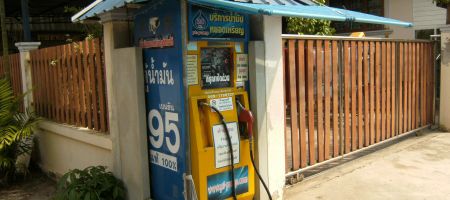
In Ayutthaya. A fuel pump in the format of a cash machine, quite cute. Though, I have to add, I am not sure if this isn’t from a major fuel company here in Thailand.
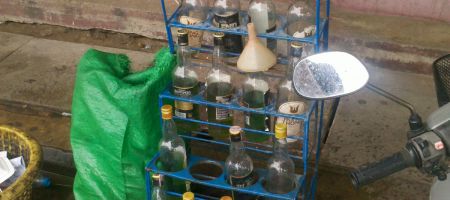
Fuel in bottles sold at 30 baht each at a snack shop – for motorcycles. I thought gasoline would be yellowish… What kind of stuff is that?

Another one of these tiny fuel pumps. Oh, pardon me, it’s just a telephone cell. I would have said that they are a dying species, but this is wrong, they are still around every corner here. They are just not really used anymore, never saw anyone using it.

Flooded
Lena left for Bangkok today and we will meet up for the second part of our beach holiday on this Friday as the students have midterm tests so there will be no classes the next week.
Now that I am writing this (not now that I am posting this, I wrote this day before yesterday), it has been raining for 20 hours almost without pause. Speed boats going to the island are cancelled for today because of heavy winds. Lena sent me by sms that on her way back to Bangkok (I am staying here for a few more days), that some towns are knee-deep in water with sand sack barriers in front of shops and that the traffic advanced only at walking-pace at times. She even saw a boat on a road.
It surprised me how fast the towns are flooded in Thailand during the rainy season. A full day of rain can still be considered as normal here, still already a few hours of rain is enough to fill the canalisation so that water starts to flood the streets. Specifically, I am talking about the university campus and Golf View in Rangsit, not about Ko Mak. These are definitely urban and quite newly-built areas. Instead of a proper canalisation to the nearby canal, there are people employed at Golf View who remove the water from the streets after the rain is over with buckets.
But well, after all (at least) the Bangkok area of Thailand is built on top of swamps. It can very well be no matter how good the canalisation system, the water level is already so high that there is simply no place where the water can flow away to, I can not judge that.
You know the traditional Thai houses? Traditional Thai houses are wooden houses built on stilts, the ground floor only serves as a garage, workshop and all-purpose area. Living room, kitchen, sleeping areas etc. thus are all in the first floor. Now I know why.

Beach Holidays
It took me three weeks to finally visit one of the many islands in Thailand.
Lena has quite a unfortunate class schedule this semester, she has only 14-something hours to teach, but her lessons are scattered all over the week in a way that she doesn’t have more than two days off in a row as she has to get to Bangkok center for a class on Saturday.
So far I didn’t really want to visit all the “cool places” without her.
But this weekend, there were some holidays in Thailand so we had time for 4 days in a row. We decided to visit Ko Mak. Ko Mak is a beautiful tropical island far away from the tourist centers and is (supposed to be) laid-back even during high season. It’s shores are skirted by beaches, coconut palmtrees and inviting wooden bungalows. While exploring the island, we also saw a few gum plantages. On the northern end of the island, following a signposted bicycle trail, we also visited one of the three(?) villages on the island which was titled as “primitive community” by the bicycle trail signs :-D. I wonder why the people in that village are not offended to be called primitive by these signs (and who put them up).
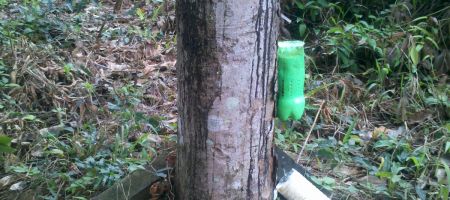
Gum tree
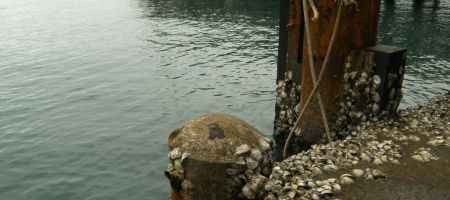
One of the piers
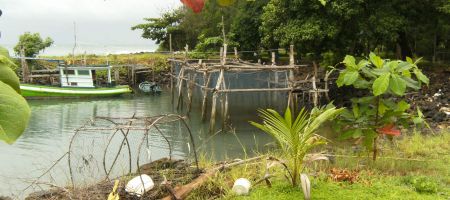
Crab traps (I think)
On this island, it is quite apparent during low season that it is low season, though.
I’d say about three quarters of all the accommodation and restaurants are closed. Speed boats go only twice a day and had to be booked in advance. Regular wooden ferries just go twice a week and take three hours to reach the island.
Also, one can expect that it will rain heavily at least once a day. It’s still 27°C here, so it is a warm rain and it didn’t hinder us to rent bicycles and explore the island. Much to Lena’s demise, I had to stop every few hundred metres and note down the street names for the mapping project and of course, I had a general tendency to cycle down the uncharted muddy tracks instead of the concrete main roads. ;-)
Here is a map of the gps trace and the notes I made during our bicycle tour(s):
Comment [1]

Modern Cartography
For everyone who wonders what I am doing here, apart from travelling and making half-hearted attempts at learning the Thai language: I contribute to the OpenStreetMap project!
What is OpenStreetMap? I will just cite what JOSM gives as a description:
“OpenStreetMap is a project aimed squarely at creating and providing free geographic data such as street maps to anyone who wants them. The project was started because most maps you think of as free actually have legal or technical restrictions on their use, holding back people from using them in creative, productive or unexpected ways.”
For places I travel to (and live), I track the path I took with my smartphone. These GPS traces can be uploaded to OpenStreetMap and serve as auxiluary data for people who map an area. The only thing one needs for that is a GPS-enabled smartphone or a GPS receiver.
The other way to contribute is to directly edit the map, taking as a source either Bing satellite imagery1, other copyright-free maps or the data gained by an own expedition into that area, using your own GPS traces with points of interests noted down. One can edit the map directly on www.openstreetmap.org through the “Edit” tab in the browser, just like Wikipedia.
Here an example of a super-detailed part of map because this is where I have my flat ;-). I’d love to show you before-after images forgot to take a before-screenshot. So just let me tell you that the area shown in the screenshot just consisted of the canal there before I added the rest to the map.
This is what I’ve been doing. Check out the next blog article to see how such a GPS trace with points of interest noted down on my smartphone looks when I return from a survey.
1 That’s right, evil open-source fiend Microsoft supports OpenStreetMap by allowing OSM contributors to use their satellite imagery to be used as a source without imposing any limitations on the derived data. As opposed to Google by the way, who even just launched their own crowdsourcing application to enhance their maps by community contributions. On that topic, read this!

Salt & Pepper
In restaurants in Germany, there is always salt & pepper on the table. In Spain, it is oil and vinegar and what is on the table in Thailand?
(from right to left:) Chili powder, Tabasco pepper sauce, pepper, another pepper sauce, a chili sauce, another chili sauce aaand Maggi sauce. What doesn’t fit? ;-)
Maggi is really a more common sight on tables than soy sauce, that quite surprised me.

Buddha comic
Found this comic about the life of Buddha in a 7-Eleven mini supermarket. It was standing in the shelf at TOP 3. An insight into the Thai comic style and that it is different from japanese manga.
Also on the same shelf:
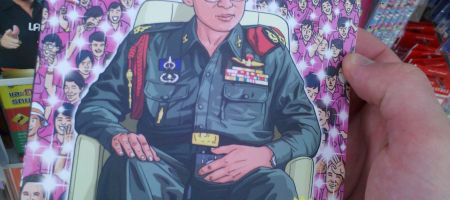
One about the life of the king. One has to understand that the royal family here is extremely popular, there are photos and posters of him everywhere: above the family shrine (often next to photos of certain monks), in bars, cafes and shops, in tuk-tuks or in extra large at main roads and roundabouts.

My new home
Everytime when I start a new travel, I get so many new impressions that I don’t know where to start with. So I’ll just skip with any kind of introduction and instead show you some pictures of my new home in Rangsit, a suburb of Bangkok.
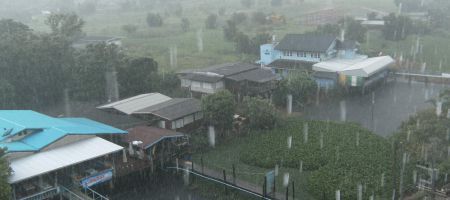
View to the same restaurant from my balcony. It is the rain season. Of course, that doesn’t stop the temperature to climb over 35 degrees celsius almost each day.
Comment [1]


